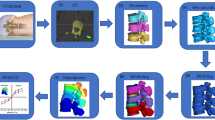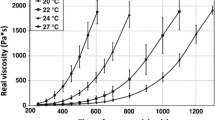Abstract
Purpose
Vertebral augmentation is an established treatment for patients with pathological vertebral compression fractures. These procedures typically employ a PMMA-based bone cement, which possesses a high compressive stiffness. Because of the increased risk of subsequent fractures after vertebral augmentations, there is a desire for reducing this stiffness. The goal of our study was to examine the influence of adding isotonic saline on the biomechanical properties of PMMA vertebroplasty cement.
Methods
A PMMA-based vertebroplasty cement was prepared according to the manufacturer’s recommendations after which isotonic saline was mixed into the cement at 10, 20, and 30% (volume:volume). Testing bodies were cast, and compression and bending tests were performed. Fracture surfaces were studied using SEM. Measurements of injectability, setting temperature, and radioopacity were also performed.
Results
The addition of saline solution (of up to vol-30%) led to a pronounced reduction in the compression modulus of the cement from 3409 ± 312 to 1131 ± 127 MPa. In parallel, maximal compression strength was reduced from 86 ± 4 to 33 ± 3 MPa and bending strength from 40 ± 4 to 24 ± 3 MPa. The differences regarding injectability, setting temperature, and radioopacity were small and probably of no clinical relevance.
Conclusions
The compressive stiffness of PMMA-based vertebroplasty cement can be reduced to almost a third by the addition of saline. The probable explanation is an increase in microporosity. Future simulator experiments will show whether the achieved reduction in stiffness is large enough to reduce the rate of subsequent vertebral fractures.





Similar content being viewed by others
References
Rho YJ, Choe WJ, Chun YI (2012) Risk factors predicting the new symptomatic vertebral compression fractures after percutaneous vertebroplasty or kyphoplasty. Eur Spine J 21:905–911. doi:10.1007/s00586-011-2099-5
Mudano AS, Bian J, Cope JU, Curtis JR, Gross TP, Allison JJ, Kim Y, Briggs D, Melton ME, Xi J, Saag KG (2009) Vertebroplasty and kyphoplasty are associated with an increased risk of secondary vertebral compression fractures: a population-based cohort study. Osteoporos Int 20:819–826. doi:10.1007/s00198-008-0745-5
Wilcox RK (2006) The biomechanical effect of vertebroplasty on the adjacent vertebral body: a finite element study. Proc Inst Mech Eng H 220:565–572
Ren HL, Jiang JM, Chen JT, Wang JX (2015) Risk factors of new symptomatic vertebral compression fractures in osteoporotic patients undergone percutaneous vertebroplasty. Eur Spine J 24:750–758. doi:10.1007/s00586-015-3786-4
Rohlmann A, Zander T, Bergmann G (2006) Spinal loads after osteoporotic vertebral fractures treated by vertebroplasty or kyphoplasty. Eur Spine J 15:1255–1264. doi:10.1007/s00586-005-0018-3
Kim JM, Shin DA, Byun DH, Kim HS, Kim S, Kim HI (2012) Effect of bone cement volume and stiffness on occurrences of adjacent vertebral fractures after vertebroplasty. J Korean Neurosurg Soc 52:435–440. doi:10.3340/jkns.2012.52.5.435
Blattert TR, Jestaedt L, Weckbach A (2009) Suitability of a calcium phosphate cement in osteoporotic vertebral body fracture augmentation: a controlled, randomized, clinical trial of balloon kyphoplasty comparing calcium phosphate versus polymethylmethacrylate. Spine 34:108–114. doi:10.1097/BRS.0b013e31818f8bc1
Urlings TA, van der Linden E (2013) Elastoplasty: first experience in 12 patients. Cardiovasc Intervent Radiol 36:479–483. doi:10.1007/s00270-012-0409-x
Schulte TL, Keiler A, Riechelmann F, Lange T, Schmoelz W (2013) Biomechanical comparison of vertebral augmentation with silicone and PMMA cement and two filling grades. Eur Spine J 22:2695–2701. doi:10.1007/s00586-013-2908-0
Gilula L, Persenaire M (2013) Subsequent fractures post-vertebral augmentation: analysis of a prospective randomized trial in osteoporotic vertebral compression fractures. AJNR Am J Neuroradiol 34:221–227. doi:10.3174/ajnr.A3156
Bae H, Hatten HP Jr, Linovitz R, Tahernia AD, Schaufele MK, McCollom V, Gilula L, Maurer P, Benyamin R, Mathis JM, Persenaire M (2012) A prospective randomized FDA-IDE trial comparing Cortoss with PMMA for vertebroplasty: a comparative effectiveness research study with 24-month follow-up. Spine (Phila Pa 1976) 37:544–550. doi:10.1097/BRS.0b013e31822ba50b
Bae H, Shen M, Maurer P, Peppelman W, Beutler W, Linovitz R, Westerlund E, Peppers T, Lieberman I, Kim C, Girardi F (2010) Clinical experience using Cortoss for treating vertebral compression fractures with vertebroplasty and kyphoplasty: 24-month follow-up. Spine (Phila Pa 1976) 35:E1030–E1036. doi:10.1097/BRS.0b013e3181dcda75
Boger A, Bohner M, Heini P, Schwieger K, Schneider E (2008) Performance of vertebral cancellous bone augmented with compliant PMMA under dynamic loads. Acta Biomater 4:1688–1693. doi:10.1016/j.actbio.2008.06.019
Boger A, Bisig A, Bohner M, Heini P, Schneider E (2008) Variation of the mechanical properties of PMMA to suit osteoporotic cancellous bone. J Biomater Sci Polym Ed 19:1125–1142. doi:10.1163/156856208785540154
Kolb JP, Kueny RA, Puschel K, Boger A, Rueger JM, Morlock MM, Huber G, Lehmann W (2013) Does the cement stiffness affect fatigue fracture strength of vertebrae after cement augmentation in osteoporotic patients? Eur Spine J 22:1650–1656. doi:10.1007/s00586-013-2809-2
Boger A, Bohner M, Heini P, Verrier S, Schneider E (2008) Properties of an injectable low modulus PMMA bone cement for osteoporotic bone. J Biomed Mater Res B Appl Biomater 86:474–482. doi:10.1002/jbm.b.31044
Lopez A, Mestres G, Karlsson Ott M, Engqvist H, Ferguson SJ, Persson C, Helgason B (2014) Compressive mechanical properties and cytocompatibility of bone-compliant, linoleic acid-modified bone cement in a bovine model. J Mech Behav Biomed Mater 32:245–256. doi:10.1016/j.jmbbm.2014.01.002
Kinzl M, Benneker LM, Boger A, Zysset PK, Pahr DH (2012) The effect of standard and low-modulus cement augmentation on the stiffness, strength, and endplate pressure distribution in vertebroplasty. Eur Spine J 21:920–929. doi:10.1007/s00586-011-2119-5
Lam WM, Pan HB, Fong MK, Cheung WS, Wong KL, Li ZY, Luk KD, Chan WK, Wong CT, Yang C, Lu WW (2011) In Vitro characterization of low modulus linoleic acid coated strontium-substituted hydroxyapatite containing PMMA bone cement. J Biomed Mater Res B Appl Biomater 96:76–83. doi:10.1002/jbm.b.31741
Slane J, Vivanco J, Meyer J, Ploeg HL, Squire M (2014) Modification of acrylic bone cement with mesoporous silica nanoparticles: effects on mechanical, fatigue and absorption properties. J Mech Behav Biomed Mater 29:451–461. doi:10.1016/j.jmbbm.2013.10.008
Ahn DK, Lee S, Choi DJ, Park SY, Woo DG, Kim CH, Kim HS (2009) Mechanical properties of blood-mixed polymethylmetacrylate in percutaneous vertebroplasty. Asian Spine J 3:45–52. doi:10.4184/asj.2009.3.2.45
Ahn DK, Lee S, Choi DJ, Park SY, Woo DG, Kim CH, Kim HS (2009) Mechanical properties of blood-mixed PMMA in percutaneous vertebroplasty. J Korean Spine Surg 16:259–265. doi:10.4184/jkss.2009.16.4.259
Standardization IOf (2002) ISO 5833:2002. In: Implants for surgery—Acrylic resin cements. International Organization for Standardization, Vernier, Geneva, Switzerland, p 22
Birkenmaier C, Baumert S, Schroeder C, Jansson V, Wegener B (2012) A biomechanical evaluation of the epidural neurolysis procedure. Pain Physician 15:E89–E97
Holub O, Lopez A, Borse V, Engqvist H, Kapur N, Hall RM, Persson C (2015) Biomechanics of low-modulus and standard acrylic bone cements in simulated vertebroplasty: a human ex vivo study. J Biomech 48:3258–3266. doi:10.1016/j.jbiomech.2015.06.026
Persson C, Lopez A, Fathali H, Hoess A, Rojas R, Ott MK, Hilborn J, Engqvist H (2016) The effect of oligo(trimethylene carbonate) addition on the stiffness of acrylic bone cement. Biomatter 6:e1133394. doi:10.1080/21592535.2015.1133394
Acknowledgements
The authors wish to thank the German Spine Foundation (Deutsche Wirbelsäulenstiftung) for its crucial financial support of this study.
Author information
Authors and Affiliations
Corresponding author
Ethics declarations
Conflict of interest
None of the authors has any potential conflict of interest.
Rights and permissions
About this article
Cite this article
Schröder, C., Nguyen, M., Kraxenberger, M. et al. Modification of PMMA vertebroplasty cement for reduced stiffness by addition of normal saline: a material properties evaluation. Eur Spine J 26, 3209–3215 (2017). https://doi.org/10.1007/s00586-016-4845-1
Received:
Revised:
Accepted:
Published:
Issue Date:
DOI: https://doi.org/10.1007/s00586-016-4845-1




